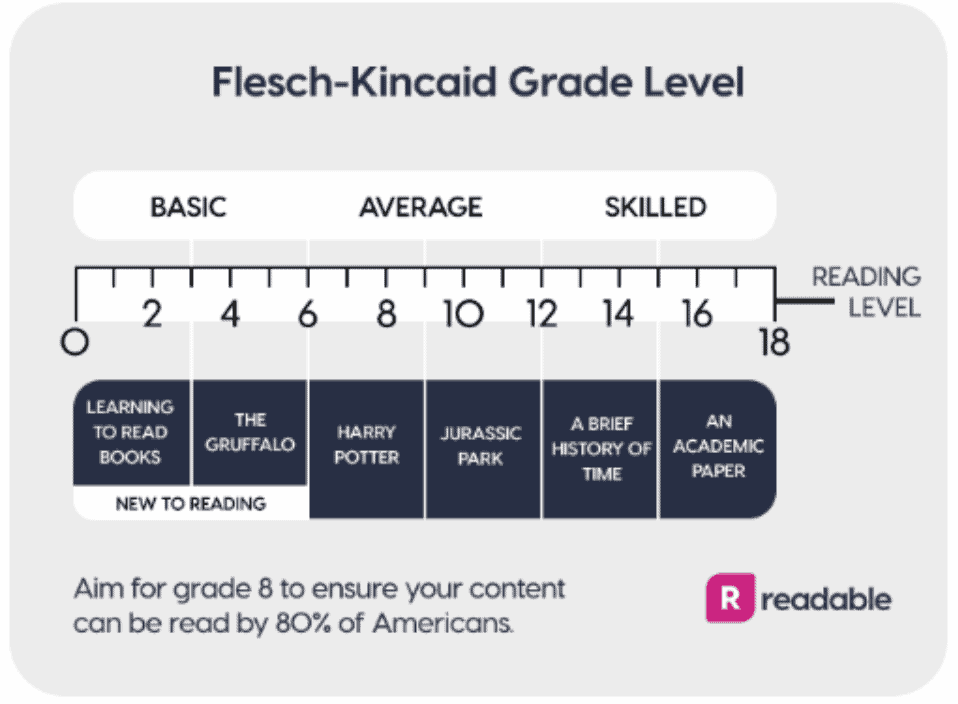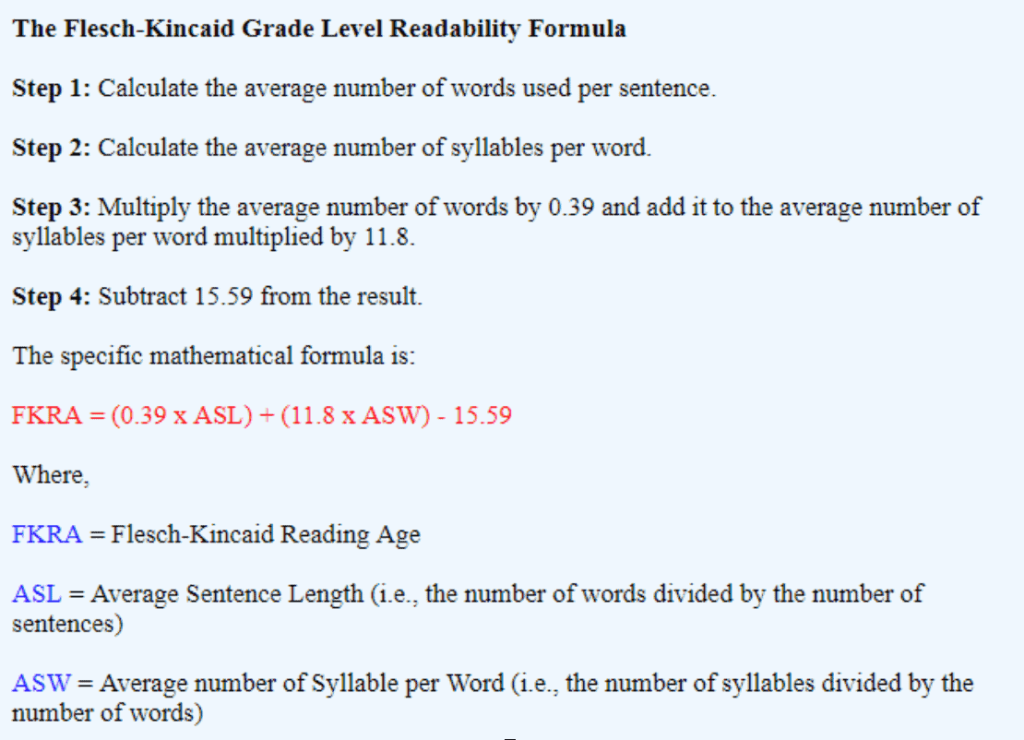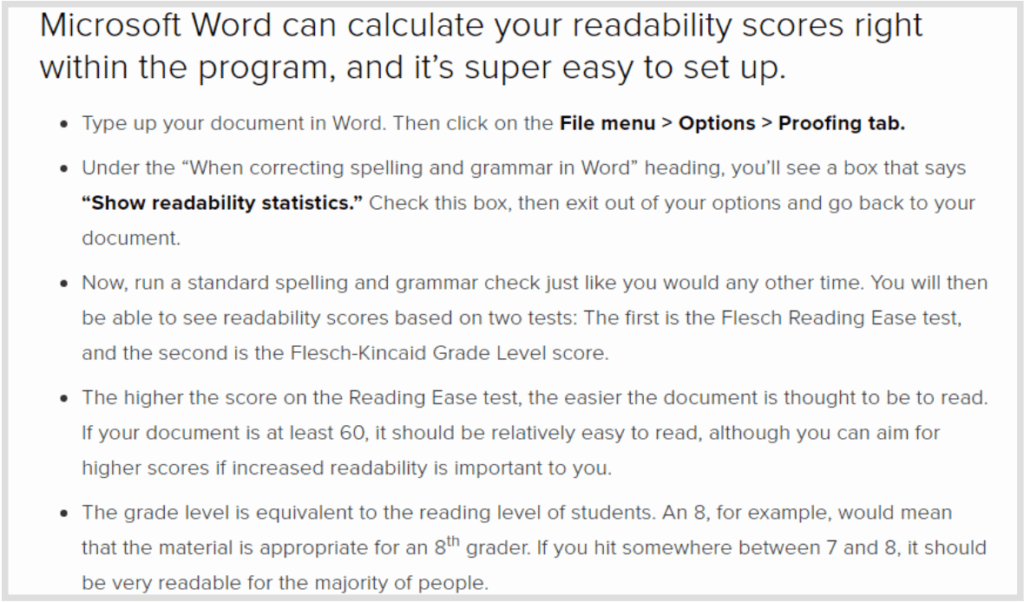“Search engine optimization” can be a confusing term. Yes, it involves the strategic use of keywords to help your content rank highly in search results, but that’s only one side of the coin. It is also important to optimize content to appeal to human readers by presenting useful information in an understandable way. One way to accomplish this is by creating and publishing content at a readability level that is appropriate for your intended audience. One of the most popular tools to use to measure readability is the Flesch Kincaid grade level readability scale.
What Is Readability?
Before we get into how to use the Flesch Kincaid scale to measure readability, let’s first define what readability is.
Readability is a measure of how easy or difficult your content is for the average reader to read and comprehend. For example, a technical manual or academic paper that uses a lot of complicated vocabulary and industry-specific jargon has low readability because only people with specialized knowledge can understand it with ease.
On the other side of the spectrum, a storybook intended for elementary school students typically uses short words and brief sentences, making it easy for readers at almost any level to understand, and therefore more readable.
Top Two Factors of Readability: Presentation and Context

There are two important concepts to understand about readability. The first is that it has less to do with the content itself and more to do with the way it is presented.
In other words, a complex topic does not automatically imply a text that is not easily readable, or vice versa. It is entirely possible to explain intricate subject matter in a simplified manner. The second concept to understand is that a readability score is not inherently good or bad. The level that you want in any given piece of content depends upon the audience for whom you are writing it.
For instance, if you were writing a piece for publication in a scholarly journal for an audience of physicians about how hand-washing can help stop the spread of disease, it would be appropriate to use medical terminology that may not be comprehensible to the general public.
However, if you were writing a piece explaining to schoolchildren why it is important for them to wash their hands before eating, you would try to present the information in a way that kids could easily understand. Therefore, you would use simplified words and short sentences for high readability. The information is similar, but the way in which you present it changes based on the needs of your audience.
Why Is Readability Important?
Aiming for average readability when creating web content can help you reach as wide an audience as possible without either boring your readers with content that is too simple or frustrating them with content that is too complicated. Readers who are bored or frustrated with your content are unlikely to linger on it long. This can hurt your search engine ranking by increasing your bounce rate. Remember that the average reader will decide whether or not your content is worthwhile within eight seconds or so of accessing the page.
Accessible readability can also help your audience to find your content in the first place. While little is known about the algorithms that Google uses to rank search results, the available evidence suggests that it currently puts user experience on at least an equal footing with keywords as a ranking criterion, perhaps even showing a slight preference over the former.
When you write with readability in mind, you’ll adapt the presentation of the topic for the audience at hand.
How Can You Measure Readability?
You should gauge the readability of your content by using the same tools that search engines do: mathematical formulas. There are a wide variety of readability formulas available, but one of the most commonly used SEO readability tools is the Flesch-Kincaid Readability Score.
What Is the Flesch Kincaid Readability Score?
So, what is the Flesch-Kincaid Grade Level Test? It derives from an earlier measure of readability called the Flesch Reading Ease Formula. The Flesch Reading Ease test was created in 1948 by Rudolph Flesch, an Austrian-born scholar and author. At the time, he was working with the Associated Press as a consultant to develop methods of improving newspaper readability.
Flesch Reading Ease Scale
The Flesch Reading Ease scale assigns each piece of writing a readability score between 0 and 100. The number assigned indicates the level of readability:

As you can see, academic or technical articles that are difficult to read receive low Flesch readability scores, while simpler texts receive Flesch reading scores on the high end. Articles that score within the middle range of about 50 to 80 on the Flesch Reading Ease scale should be understandable to readers at an average level.
Flesch Reading Ease Score Drawbacks
While the Flesch Reading Ease scale is a useful tool, it has its drawbacks. For one thing, the formula used to calculate the score is very complicated:

For another, it is not readily obvious what the numbers on the Flesch Kincaid scale mean. To correctly interpret the scores, you must have prior knowledge that a low Flesch Kincaid score indicates low readability, or in other words, more complex vocabulary and sentence structure. To further complicate matters, many comparable readability scales have the opposite relationship between numerical value and readability, meaning that the lower the score, the more readable the content is.
Flesch-Kincaid Grade Level Scale
In the mid-1970s, the U.S. Navy wanted to measure the readability of its training manuals but found the existing Flesch Reading Ease scale inadequate. It engaged the help of researcher John P. Kincaid to revise the scale for ease of use and comprehension. In response, Kincaid and his fellow researchers came up with the Flesch-Kincaid Grade Level Formula.
Instead of assigning a work a seemingly arbitrary numerical readability score on a scale of 0 to 100, the Flesch-Kincaid Grade Level assigns a score on a scale of 0 to 18, with each numerical value corresponding to an academic grade level:

In other words, a text with a Flesch-Kincaid readability score of 2 should be comprehensible to a second grader, while a score of 12 indicates a text accessible to a high school senior. Middle school students, as well as the majority of Americans, should have little to no difficulty with a text scoring from 6 to 10 on the Flesch-Kincaid scale. This readability scale is much easier to follow as far as who should be able to read the content piece when only knowing the Flesch-Kincaid readability score.
How Do You Calculate Flesch-Kincaid Grade Level Score?
Part of the goal of revising the Flesch Reading Ease scale was to simplify the formula used to calculate it. The Flesch-Kincaid readability formula is as follows:

Compared to the original Flesch Reading Ease Formula, Kincaid and his colleagues succeeded in simplifying the equation. However, simple doesn’t necessarily mean easy, and that is especially true for those of us who majored in English specifically because we are mathematically impaired.
Even if you do have the mathematical skills to calculate the readability score this way, doing so requires a lot of counting. This can be very time-consuming, especially if you’re writing an article that exceeds 1,000 words. Instead of applying the formula to the entire text, it may be easier to calculate the grade level of a few chosen paragraphs to give you an idea of the readability of the entire piece.
Syllables and Sentence Length Matter
The key variables in the Flesch-Kincaid formula are average sentence length and average syllables per word. Therefore, you may be able to get a general idea of how readable your content is by looking at these variables without plugging them into the formula. For example, recommended sentence length for higher readability is 20-25 words. You can count a few sentences to see whether they’re within the acceptable range. Sometimes you can also just tell by looking whether a sentence is long or short by comparing it to the other sentences around it.
Similarly, it follows logically that longer words tend to have more syllables, so you can count the number of long words without having to count the syllables. Then you can calculate their average number to give you a rough idea of your document’s readability.
Check Flesch-Kincaid Readability Scores in Microsoft Word
Another option is to leverage the power of technology to perform the difficult Flesch Kincaid readability score calculations for you. You may not even need any extra tools or apps to accomplish this if you are using Microsoft Word. Depending on the version you’re using, you may be able to calculate both Flesch Reading Ease and Flesch-Kincaid scores within the program itself:

However, this tool may not be available to everyone. When I tried to test it, the option to show Flesch Kincaid readability statistics was grayed out.
Other Online Flesch Kincaid Readability Tools
There are several free online apps available to calculate readability. Each has pros and cons. The Writer will require you to create an account and register your email address. Readable, on the other hand, uses a plug-and-play interface that allows you to copy and paste text directly into the display field and get instant results. However, it also assigns a letter grade to your writing that could hurt your self-esteem.
For example, I ran an earlier draft of this article through Readable and ended up with a Flesch-Kincaid score of 12.4, which the app graded a “D” for readability. Even though I am writing this article for an audience of experts, it stung a little to have a low letter grade applied to my writing. With revision, I have decreased the current draft to a grade level of 10.8. This moved the text to the outer limits of average readability and improved my letter grade to a “C.”
The Flesch Kincaid readability calculator you choose may also depend on the platform you use to write content. Yoast SEO is an example of a plug-in meant to calculate Flesch Reading Ease Score in WordPress and also gives you tips on how to improve your readability score in WordPress. However, it does not calculate Flesch-Kincaid scores.
What Else Can You Do To Optimize Readability?

There are plenty of factors beyond average syllables and sentence length from a Flesch-Kincaid or Flesch Reading Ease score that help to put readability in that sweet spot of middle-grade-level range. Here are some other things you can do to increase readability:
1. Improve the Page’s Appearance
This has no bearing on your readability score, but text that is broken up with lists, headers, and white space appeals to readers’ aesthetic sense and makes scanning the text easier.
2. Shorten Paragraphs
It is not only sentence length that contributes to readability but paragraph length as well. Try to aim for paragraphs of five sentences or fewer.
3. Avoid Passive Voice
Once in a while it is appropriate to use passive voice, but active voice is much more engaging. Passive usage of 10% or less is acceptable.
4. Choose Your Words Carefully
As one of my heroes, Jim Henson, once said, “Simple is good.” At the same time, however, he wasn’t afraid to get more complicated when he knew it would improve the final product. As a general rule, it is better to choose short, simple words over long, more complex ones, but don’t be afraid to use the latter where it would have more impact.
5. Know When To Break the Rules
These are general guidelines that do not work in every situation. Always keep your audience and rhetorical purpose in mind when applying them.
Readability Conclusions
Above all, never lose sight of the human factor in your SEO efforts. Always adhering to a Flesch-Kincaid readability score in order to deem content “acceptable” won’t work in every situation. For example, an article that includes medical, technical or legal jargon is going to require that you use longer words that have more syllables because those are the actual names of the things you’re writing about. You don’t want to overdo it and take out important words that would make more sense to a human just to appease a mathematical equation.
Always use your best judgment and re-read your content before posting. Most times, a combination of gut instinct merged with helpful readability tools will do the trick in helping you create really great content. In fact, that’s exactly what I did in this article!
A successful content marketing strategy needs to take readability into account. Whether that’s through the Flesch Kincaid Grade Level Scale or by some other means, it needs to be considered.


Leave a Reply